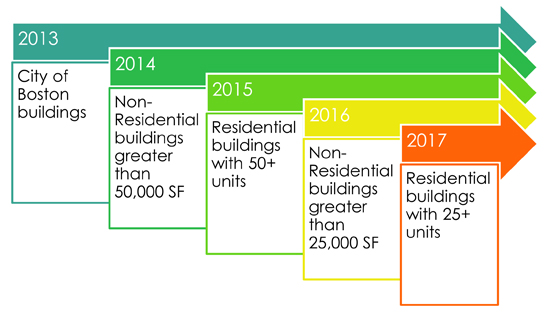
Last Thursday Boston City Council heard discussion on the proposed ordinance that would require disclosure of energy and water usage information. The Mayor has proposed the ordinance as part of the City’s efforts to achieve a 25% reduction in carbon emissions by 2020. The advocates for the ordinance feel that the knowledge gained from tracking energy usage will lead building owners to improve their energy usage, help inform more effective energy policies and allow consumers to make more educated decisions. Boston would join seven other cities, such as New York, and two states, California and Washington, that have already adopted mandatory energy disclosure policies.
Proposed Schedule

The ordinance would require all large and medium sized buildings to report annual energy and water data through the ENERGY STAR Portfolio Manager reporting tool. The requirements would roll out starting with City owned buildings this year to full city-wide adoption by 2017 and ultimately require all non-residential buildings over 25,000 SF and residential buildings with more than 25 units to participate. Multi-tenant residential and commercial buildings would be required to report tenant energy usage, as well. The City is working with NSTAR and National Grid to create an automated process to ease the reporting process. Buildings that are below the 75th percentile in ENERGY STAR (if eligible) or are not demonstrating progress in energy reduction would be required to get an energy audit every five years. Annual energy and water intensity of buildings would be made publically available.
While many organizations have come out in support of the ordinance, including the Boston Society of Architects and the USGBC of Massachusetts, there has been push back against the proposed ordinance from other organizations. The critics concerns are that it is a data collection exercise without any clear benefit, and that the requirement for energy audits would place financial stress on organizations.
So, is there a benefit that could come from a disclosure ordinance?
The City of Boston has adopted the mantra of “what gets measured gets managed.” Z Smith of Eskew+Dumez+Ripple has a great example of the impact this could have. Toronto benchmarked the energy use intensity (EUI) of 50 schools built more or less at the same time with a similar budget and design, but yet there was about a 3:1 ratio from the best to worst performer. When the principal of the most energy intensive school saw that report, she implemented low and no-cost energy efficiency measures that moved her to the middle of the pack of schools. People respond to competition.
Last October the EPA published a report that shows buildings that consistently benchmark energy usage save energy. Based on four years of data for over 35,000 buildings utilizing the ENERGY STAR Portfolio Manager, the EPA observed an average annual decrease of 2.4% in energy usage, or 7% over the 4 year period. What is even more exciting is that the biggest savings was seen in the most energy intensive buildings, with the buildings that started with a score below 50 saving twice as much energy as those starting above 50. This report suggests that slow and steady improvements can been seen over time from buildings that benchmark energy and water consumption.
As an architectural firm, PAYETTE is a signatory to the AIA 2030 Commitment. Like the disclosure ordinance, it requires firms to track and benchmark their progress towards meeting the carbon reduction challenges set forth in the Commitment. While public disclosure is not required and information publicly shared as an industry aggregate, the activity of benchmarking projects has already improved the knowledge and understanding of energy in our practice. This compiled and benchmarked data from past projects has started to inform our current work where we can draw upon past examples for effective energy reduction strategies and identify new limits where we try to push our projects. I can only image that measuring and tracking building performance data will have a similar cultural impact in other organizations.
One of the current challenges with benchmarking is that there is still often a lack of good data for designers. This and other similar ordinances will provide local examples and continue to expand our data set. This data can also be used to help the City develop more targeted and effective technical assistance programs, as they can observe the areas where the most investment may be needed. Additionally, the disclosure of information will build our community’s knowledge base for energy literacy. Just like a concerned consumer may check the miles per gallon of a new car or the facts on a nutrition label, building performance disclosure will create a public who can make more informed decisions on the issues that may matter to them.
There may be some truth to the criticism that requiring energy audit every five years adds a financial burden to the owners of inefficient buildings. However, if these owners implement the some of the energy saving strategies found in the audit, which typically identify ranges of strategies from low-hanging fruit with no upfront cost to measures requiring additional capital, they should be able to offset the cost of the audit through operational savings and utility incentives for implementing energy saving strategies. As their building is transformed to a high performance building, many studies have shown that buildings that are LEED or ENERGY STAR certified can charge higher rents and have lower vacancy rates, providing additional financial incentives down the road.
While the gains seen from tracking and benchmarking building performance may be small at 2-3% annually, when these gains occur over a large swath of the building stock of Boston they can become substantial. Additionally, the public knowledge and ancillary benefits that will also be gained for the City will be valuable in working towards their goal of a 25% reduction in carbon by 2020. Hopefully Boston will continue to demonstrate its greater leadership that has been shown on energy efficiency, and will adopt the Building Energy Reporting and Disclosure Ordinance.


